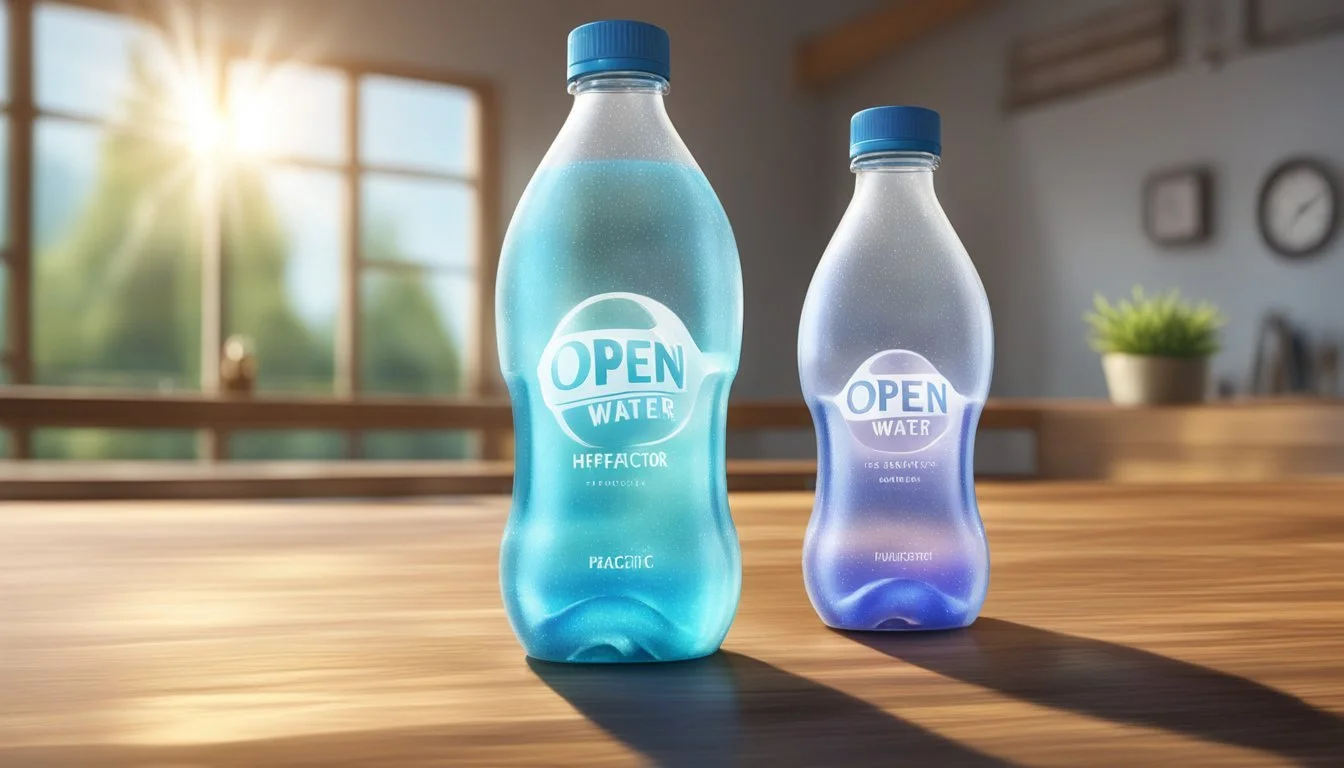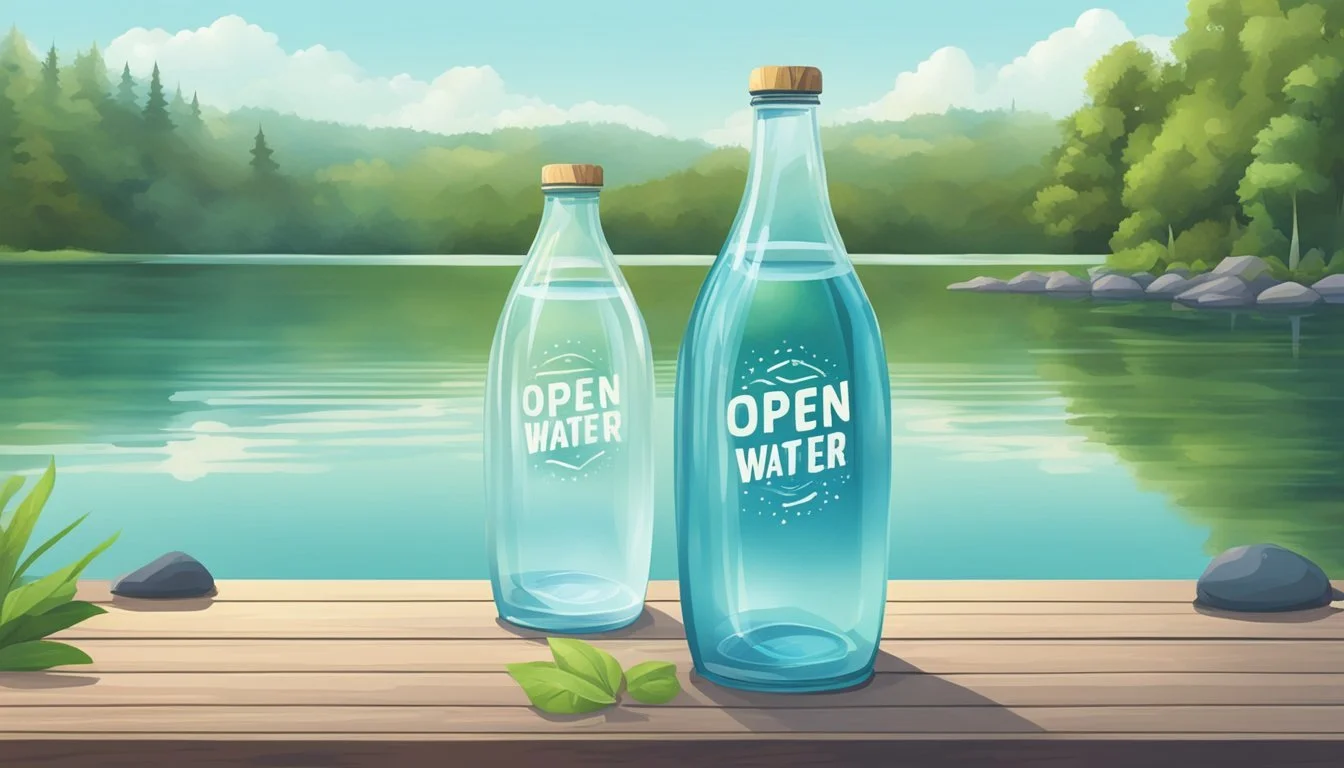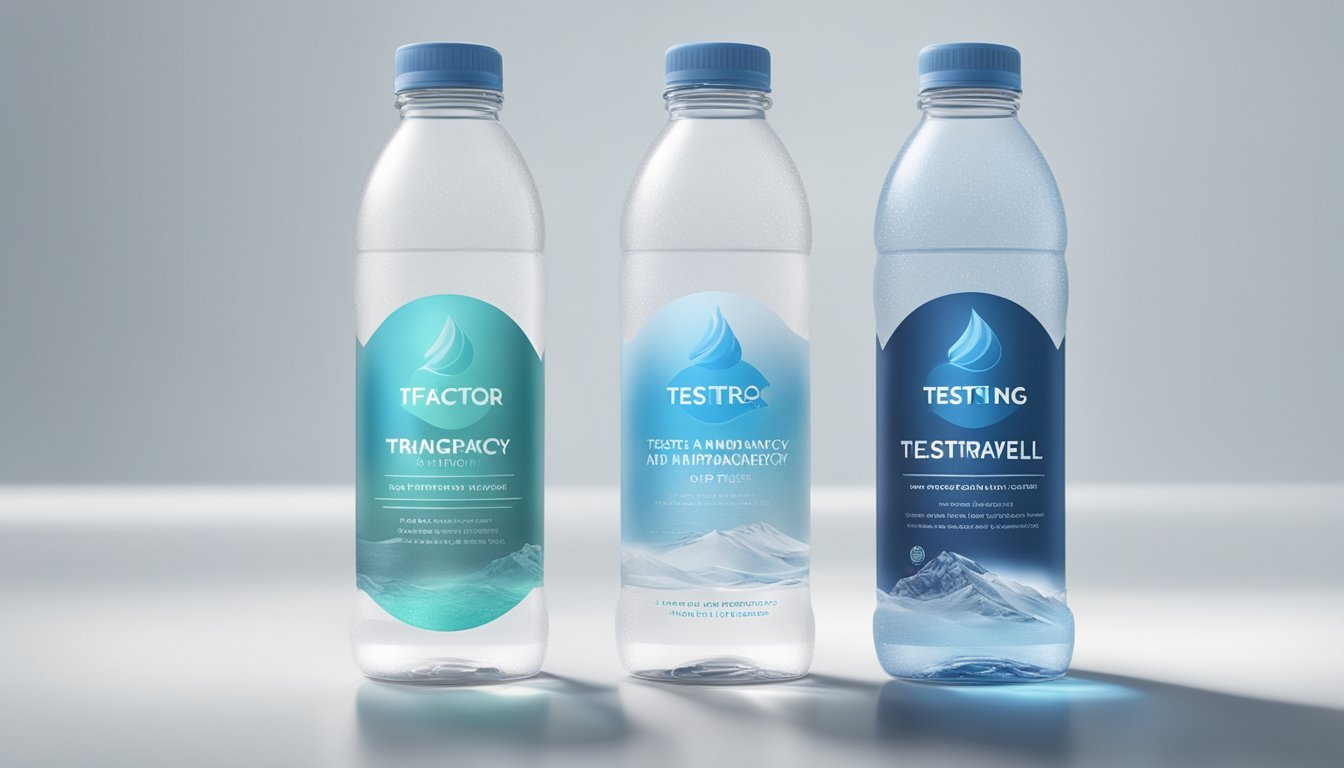Open Water vs. HFactor
Comparing Bottled Water Quality
When choosing between Open Water and HFactor, consumers often seek insights into their unique benefits and drawbacks. Open Water, recognized for its pure and clean taste, makes an excellent choice for those prioritizing sustainability and straightforward hydration. In fact, Open Water's focus on environmentally friendly packaging sets it apart in the crowded bottled water market.
Bold claims surround HFactor, a hydrogen-infused water, with proponents highlighting potential health benefits. The premium pricing of HFactor reflects its specialized production process and niche market appeal. For those looking to experiment with cutting-edge hydration trends, HFactor offers a distinctive experience that goes beyond standard bottled water options.
Choosing between Open Water and HFactor ultimately depends on one’s priorities. Whether it’s the clean taste and eco-friendly approach of Open Water or the innovative health-centric promise of HFactor, informed consumers can find an option that best fits their hydration needs.
Evaluating Water Sources
When choosing between Open Water and HFactor, understanding the origin and quality of the water is crucial. This section examines the dynamics of tap water, the essentials of bottled water, and specifically looks at the sources of Open Water and HFactor.
Tap Water Dynamics
Tap water commonly originates from municipal sources, which include surface water (like lakes and rivers) and groundwater from wells. These sources are treated through various filtration and purification processes to meet regulatory standards for safe drinking water.
Municipal water treatment typically involves several stages: sedimentation, filtration, and disinfection. Sedimentation removes large particles, while filtration (through sand, carbon, or other media) eliminates smaller contaminants. Disinfection, often using chlorine or ultraviolet light, kills harmful microorganisms.
Private wells also supply tap water but lack the standardized treatment of municipal systems. The water quality can vary significantly depending on geographic factors and the condition of the well and its surrounding environment. Regular testing is essential for wells to ensure safety and compliance with health standards.
Bottled Water Essentials
Bottled water comes from various sources, including springs, wells, and purified municipal supplies. Spring water and mineral water must be from natural, protected underground sources and retain their original composition of minerals.
Bottled water undergoes strict but different regulation than tap water. For example, in the United States, the FDA regulates bottled water, while the EPA oversees tap water. Despite this, a significant portion of bottled water is simply treated municipal water. It may go through additional processes like reverse osmosis, distillation, or ozonation for extra purity.
Packaging is a notable aspect of bottled water, affecting taste and potential microplastic contamination. Studies have found that a large percentage of bottled water contains microplastic particles from packaging, raising concerns about its long-term health impacts.
Examining Open Water and HFactor Sources
Open Water sources its water from natural springs and ensures it contains beneficial minerals while maintaining a balanced pH. The company focuses on sustainability, using eco-friendly bottling materials and promoting practices that reduce environmental impact.
HFactor, on the other hand, differentiates itself by infusing its water with molecular hydrogen, which is claimed to provide various health benefits. The water is usually sourced from municipal systems but undergoes additional filtration and hydrogenation processes before packaging.
Key differences include the sustainability focus of Open Water versus the innovative hydrogen infusion of HFactor. HFactor's unique selling point is the purported health benefits of hydrogen-enriched water, whereas Open Water highlights its natural mineral content and environmental initiatives. Both aim to provide high-quality drinking water, each with distinct features and market appeals.
Health and Safety Considerations
Choosing between Open Water and HFactor requires careful consideration of health and safety aspects. Examining water contaminants, health benefits of proper hydration, and compliance with safety regulations is essential.
Understanding Water Contaminants
Water contaminants can vary widely, including chemicals, bacteria, and heavy metals such as lead. The Environmental Protection Agency (EPA) monitors these contaminants to ensure safe drinking water. Bottled water brands like Open Water and HFactor must meet strict standards to eliminate harmful substances.
Key Contaminants Monitored:
Lead: Can cause developmental delays in children.
Bacteria: Pathogenic microorganisms can lead to illnesses.
Chemicals: For instance, pesticides or industrial chemicals that may pose health risks.
Open Water and HFactor undergo regular testing to ensure compliance with EPA standards.
Health Benefits of Quality Hydration
Proper hydration is crucial for overall health. Open Water and HFactor both provide essential hydration but may differ in additional health benefits.
Mineral Content:
Open Water often contains beneficial minerals, depending on the source.
HFactor is known for its hydrogen-infused water, which some believe can reduce inflammation.
Hydration helps maintain bodily functions, supports cognitive performance, and promotes skin health. The quality of water—free from harmful contaminants—ensures these health benefits without adverse effects.
Safety Standards and Regulation Compliance
Both Open Water and HFactor must adhere to regulations set by the Food and Drug Administration (FDA) and the Centers for Disease Control and Prevention (CDC).
Regulatory Bodies:
EPA: Sets standards under the Safe Drinking Water Act.
FDA: Regulates bottled water safety and quality.
CDC: Provides guidelines for safety in drinking water.
Open Water emphasizes environmental sustainability alongside regulatory compliance, whereas HFactor focuses on technological innovations in water purification and enhancement. Both brands undergo rigorous scrutiny to ensure their products are safe for consumption, adhering to the stringent guidelines for bottled water.
Taste and Quality
When comparing Open Water and HFactor, it's crucial to evaluate taste, mineral content, and the influence of packaging.
Taste Test Comparisons
Open Water is known for its crisp and clean taste. In blind taste tests, many found it refreshing without any metallic or plastic aftertaste.
HFactor boasts a slightly sweet flavor profile due to its hydrogen infusion. This gives it a unique, smooth finish.
Preference often comes down to individual taste, with some preferring the neutral taste of Open Water, while others lean toward the subtly sweet essence of HFactor.
Mineral Content and Water Purity
Open Water sources its product from purified sources and ensures a balanced mineral content. This balance enhances its clean taste and maintains its purity.
HFactor, while also purified, focuses on hydrogen infusion. The mineral content remains lower to reduce any potential changes in taste.
Both brands prioritize purity, but their approach differs. Open Water emphasizes balanced minerals, whereas HFactor highlights the benefits of low mineral content coupled with hydrogen infusion.
The Role of Packaging in Water Taste
Open Water is packaged in aluminum cans, which are less reactive than plastic. This packaging choice helps maintain the water's fresh taste.
HFactor uses pouches designed to preserve the hydrogen content.
Each brand's packaging plays a critical role in the taste experience. Aluminum cans prevent external flavors from seeping in, while HFactor's pouches ensure hydrogen levels and distinct taste remain intact.
Environmental and Economic Impact
The environmental and economic effects of bottled water significantly shape consumer choices between Open Water and HFactor. Key considerations include ecological footprints, cost factors, and the broader impact on society and ecosystems.
Bottled Water and Environmental Concerns
Bottled water production and consumption have notable environmental consequences. The manufacturing of plastic bottles, often made from PET, consumes considerable energy and fossil fuels. Open Water and HFactor's reliance on plastic packaging contributes to pollution and landfill waste.
Microplastics, which originate from fragmented plastic bottles, pose a severe risk to marine life and ecosystems. Environmental studies estimate that switching entirely to bottled water could escalate these issues, resulting in species loss and increased ecological strain. Consumers growing aware of these effects may seek more environmentally friendly alternatives.
Economic Factors of Water Choices
The cost implications of bottled water are substantial. Open Water and HFactor both cater to consumers willing to pay a premium for perceived quality and convenience. Bottled water can significantly inflate household expenditures compared to tap water, which remains largely inexpensive.
In areas like the U.S., bottled water sales have experienced fluctuations influenced by economic conditions. For instance, a decline in sales in 2008 potentially reflected economic struggles. Choosing bottled water, despite the cost, often hinges on convenience and perceived benefits versus direct financial implications.
Assessing the True Cost of Water
Evaluating the true cost of water involves looking beyond the price tag. Production costs of Open Water and HFactor include not just manufacturing but also environmental degradation. For instance, the energy used in bottling and transportation affects overall economic viability.
Studies using specific urban settings illustrate stark financial costs of exclusive bottled water consumption. For instance, if Barcelona's population fully shifted to bottled water, it would incur an additional $83.9 million annually. These figures highlight the broader economic impacts beyond individual consumer decisions.
Making informed choices requires understanding how these costs affect society and the environment. Balancing economic viability with environmental responsibility becomes crucial in determining the best option between Open Water and HFactor.
Consumer Considerations
When choosing between Open Water and HFactor, consumers should consider convenience, availability, and customization options, as well as how to make informed decisions about their water choices.
Convenience and Availability
Convenience plays a significant role in bottled water selection. Open Water is often found in major retailers and online stores, making it widely accessible. HFactor, with its niche market focus, might be available in select health stores or specialty shops.
Both brands offer single-use bottles, but consumers looking for environmentally conscious options might find Open Water's aluminum packaging more appealing. Open Water’s cans are more recyclable compared to plastic, making it a sustainable choice.
Variety and Customization Options
Open Water and HFactor each provide unique offerings. Open Water is known for its simple, purified water in environmentally friendly aluminum cans. It appeals to consumers seeking a straightforward and eco-friendly hydration option.
HFactor, on the other hand, emphasizes enhanced hydration with its hydrogen-infused water. This brand may appeal more to health-conscious individuals or athletes. However, HFactor's lack of flavor options could limit its appeal to those who prefer flavored water.
Making Informed Decisions about Water
Consumers should consider the source and processing methods of their bottled water. Open Water is carbon-filtered and purified, ensuring high-quality drinking water. This process removes contaminants and provides a clean taste, essential for those concerned about water purity.
HFactor promotes its hydrogen-infused water for potential health benefits. While these claims can be enticing, it is crucial to examine scientific backing and personal hydration needs. Consumers aiming for health benefits should review credible sources and possibly consult health professionals.
By evaluating these factors, consumers can make better-informed choices that align with their needs and values.
Testing and Transparency
Both Open Water and HFactor's bottled water products undergo various testing and reveal differing levels of transparency in their sourcing and treatment processes. Consumers can access quality reports to evaluate the safety and purity of these bottled waters. This section dives into these critical aspects, examining how these brands measure up.
Analyzing Independent Testing Results
Open Water and HFactor are subject to independent testing to assess the presence of any potential contaminants and verify the overall safety of the product. Open Water is known for its rigorous testing standards, ensuring the absence of harmful substances like heavy metals and other toxins. HFactor similarly commits to independent testing, although there is a focus on maintaining a balanced pH and reducing contaminants.
These tests often check for contaminants in drinking water such as bacteria, chemicals, and microplastics. For example, some tests reveal concerning elements like strontium in some bottled waters. Similarly, the results can show whether the water meets the regulated FDA standards for bottled water. Testing like this helps ensure legal limits for contaminants are respected, safeguarding consumer health.
Transparency in Water Sourcing and Treatment
Transparency is vital for discerning consumers who want to know the origins and treatment methods of their bottled water. Open Water excels by providing detailed information on their website and packaging about their water's source, which often comes from pristine, protected sources. They also describe their treatment processes, which include advanced filtration and purification steps.
In contrast, HFactor prioritizes transparency through clear labeling of their sourcing and treatment methods. They showcase their water's origins and the hydrogen infusion process they use to enhance their product. Transparency in this context means that both Open Water and HFactor allow consumers to make educated choices based on factual information about where and how their water is processed and treated.
Consumer Access to Quality Reports
Access to water quality reports enables consumers to verify the claims made by bottled water companies. Open Water makes these reports readily accessible, providing detailed analyses of their water quality, highlighting parameters such as pH levels, mineral content, and any detected contaminants. These reports are available online and updated regularly to reflect current testing results.
HFactor also endeavors to make quality reports available to their customers. These reports offer insights into the hydrogen levels, pH balance, and overall purity of the water. By reviewing these reports, consumers can better understand the quality of the water they are purchasing and drinking, ensuring it meets their standards for purity and safety. Having access to clear, detailed quality reports from both brands supports transparency and helps build consumer trust.
Special Considerations for Specific Groups
When choosing between Open Water and HFactor, it’s important to consider the unique needs of specific populations and situations. Sensitive populations, emergency situations, and specialty waters for unique needs all present different requirements.
Water Concerns in Sensitive Populations
Certain groups like children and the elderly are more sensitive to contaminants. Nitrates in water can be harmful, especially to infants, causing conditions like methemoglobinemia. Private wells in rural areas may not be as closely regulated, posing potential health risks.
BPA-free bottles are crucial to avoid any hormone-disrupting chemicals. Open Water, packaged in aluminum cans, is BPA-free and environmentally friendly, offering a safer option. For dental health, non-carbonated waters like Open Water can reduce the risk of tooth decay compared to their carbonated counterparts.
Disaster Preparedness and Emergency Situations
Water quality can be critical during natural disasters and emergencies. For example, the Flint, Michigan water crisis highlighted the risks associated with contaminated municipal supplies. During such situations, having reliable bottled water is essential.
Bottled water like Open Water, with long shelf life, is suitable for emergency preparedness kits. In cases where municipal water is compromised, both Open Water and HFactor offer reliable options. However, Open Water’s eco-friendly packaging and broad accessibility may make it a preferable choice during wide-scale emergencies.
Specialty Waters for Unique Needs
Hydrogen-infused waters like HFactor cater to specific health claims and fitness needs. Athletes often prefer specialty waters claiming enhanced recovery benefits. HFactor’s hydrogen infusion aims to provide added benefits, such as reduced oxidative stress.
Calcium content in water can be beneficial for bone health. Both brands may offer varying mineral contents, catering to those needing dietary supplementation. While HFactor focuses on performance, Open Water’s sustainability appeal is more pronounced, making it ideal for environmentally conscious consumers. This differentiation ensures that individuals can make informed choices based on their unique health requirements and lifestyle preferences.
More About Open Water
Aqua Carpatica vs Open Water: Which Bottled Water is Better?
Cascade Mountain vs Open Water: Which Bottled Water is Better?
Core Hydration vs Open Water: Which Bottled Water is Better?
Crystal Geyser vs Open Water: Which Bottled Water is Better?
Hawaii Volcanic vs Open Water: Which Bottled Water is Better?
Hawaiian Springs vs Open Water: Which Bottled Water is Better?
Icelandic Glacial vs Open Water: Which Bottled Water is Better?
Mountain Valley Spring Water vs Open Water: Which Bottled Water is Better?
Nestle Pure Life vs Open Water: Which Bottled Water is Better?
Open Water vs Kirkland Signature: Which Bottled Water is Better?
Open Water vs Whole Foods 365: Which Bottled Water is Better?
Richard's Rainwater vs Open Water: Which Bottled Water is Better?
San Pellegrino vs Open Water: Which Bottled Water is Better?
Solan de Cabras vs Open Water: Which Bottled Water is Better?
Talking Rain AQA vs Open Water: Which Bottled Water is Better?
Whole Foods Italian Still Mineral water vs Open Water: Which Bottled Water is Better?
More About HFactor
Whole Foods Italian Still Mineral water vs HFactor: Which Bottled Water is Better?
Richard's Rainwater vs HFactor: Which Bottled Water is Better?
Mountain Valley Spring Water vs HFactor: Which Bottled Water is Better?
Kirkland Signature vs HFactor: Which Bottled Water is Better?
Icelandic Glacial vs HFactor: Which Bottled Water is Better?





